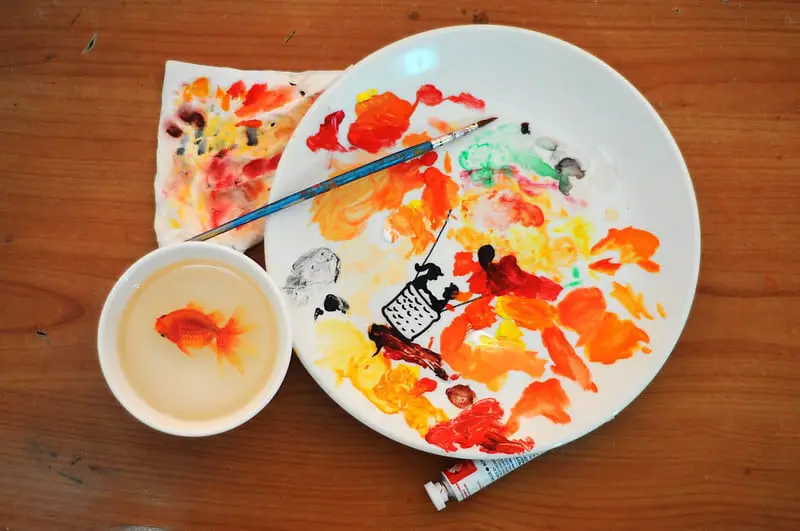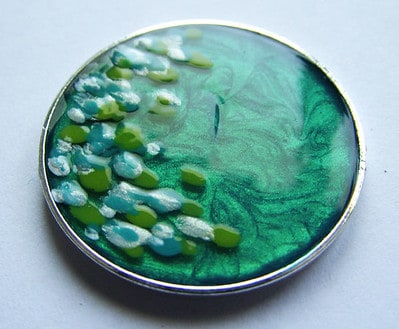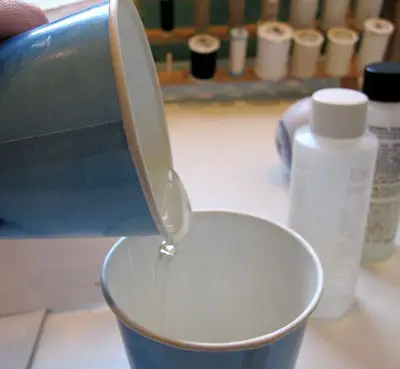Epoxy resin is a fun material that can make your next painting project a blast!
Strong, resilient, and very durable, there are a lot of advantages to using epoxy resin – particularly when it comes to the flexibility and adaptability of how this resin can be deployed. At the same time, a lot of people want to know whether or not they can use acrylic paint on resin to color and change it. Good news, you can definitely use acrylic paint with resin and give it a one of a kind look.

You have to know exactly what you’re doing before you start your project to get the right finish. In this article we go over everything you need to know for using acrylic paint with resin.
Let’s get to it!
Better Understanding of Epoxy Resins
Epoxy resins are made by combining a liquid resin material with a chemical hardening agent with one another, producing the hard resin that you are looking for in the first place. I highly recommend this resin and hardener set from Amazon to get you started.
These resins are generally available in 100% clear finishes, giving you an opportunity to add your own color, your own tint, and even your own acrylic paint to change the way that the resin looks when it has had time to set up and dry.
Pouring Resin Over Acrylic Paint

Acrylic paints are 100% water-soluble, dry very quickly, and are able to resist damage from water that negatively impacts other kinds of paint after they have already set up. This Arteza acrylic paint set is my go to for a variety of colors and styles.
Super popular in the world art because of the way that the pigment in acrylics fuse with the material as water evaporates during the hardening process, there may not be a better way to change the look and the color of your epoxy that than by using acrylic paint materials.
Pouring resin over your acrylic painted canvas gives it a glossy and unique kind of look. If you add 3D objects on your canvas it will give it a 3D type of look, which can help you create a one of kind look.
I personally love using resin over some of my canvases, especially with my abstract work. It gives it a cool look that some other sealant sprays just can’t achieve.
Can You Mix Acrylic Paint and Epoxy Resins?

Absolutely!
In fact, the overwhelming majority of artists and creative individuals that use epoxy resins in their work, recommend using acrylic paints and acrylic pigment over everything else when they want to color their surfaces.
For starters, acrylic paints are available in a myriad of different colors, shades, and configurations. This means you won’t have any trouble whatsoever finding just the right kind of acrylic paint to change the way your epoxy looks.
Also, a lot of acrylic paint options either come with or can have additives mixed in, and that gives them a neon sheen, a bit of glitter, or even glow-in-the-dark properties – and that’s just the tip of the iceberg!
All of those extra additives never negatively impact the stability of the epoxy resin that you are working with but instead further bind up with the epoxy that you are working with in the first place.
This produces a cleaner, tighter, and more durable finish while adding a lot of extra aesthetic value along the way.
Tips for Mixing Acrylic Paint with Resin
The most important thing to remember when you are mixing acrylic paint with epoxy, though, is that you need to stick to the right ratios.
If you change the flow of the resin that you are working with, you’re going to end up with a nightmare of a time getting your epoxy project to set up the way you had expected originally.
As a general rule of thumb, it’s always a good idea to stick to a ratio of 1:10, with one part of acrylic paint added to 10 parts of epoxy resin. Any higher than that ratio, and you start to get into some pretty interesting fluid issues that spoil the way your resin sets up big time.
On top of that, you need to be aware of a couple of downsides to using acrylic paint with epoxy resin as well. To kick things off, mixing acrylic paint with epoxy resin is never going to be an inexpensive proposition.

Acrylic paint (especially if you are working with larger epoxy projects) gets pretty pricey at higher quantities, and if you are mixing different colors into a single project you’re going to have to pay a decent amount of money to get the project finished the way you want it to look.
Furthermore, acrylic paint (if it hasn’t been completely mixed with the liquid part of your epoxy before the chemical hardener has been added in) can sometimes be a little difficult to spread around.
It’s not a bad idea to get your hands on a mechanical mixer that will evenly distribute your acrylic paint throughout your liquid resin material, before you add the hardener in later down the line.
Just keep these things in mind when working with acrylic paint and epoxy resins, and you should be good to go! Also, don’t forget to check out my Recommended Products Page for all your acrylic painting needs!

